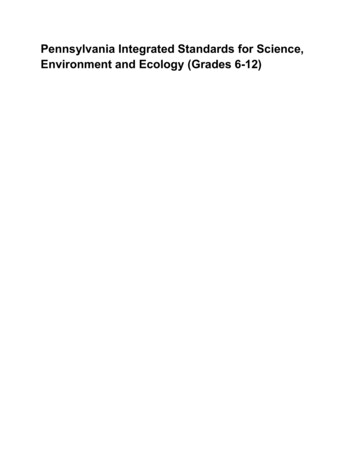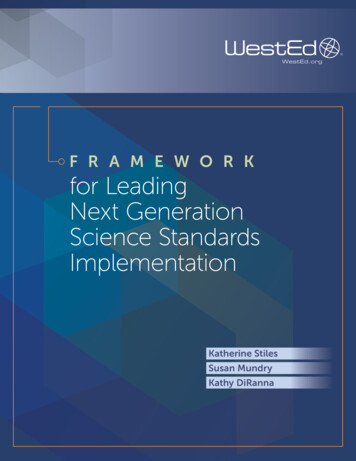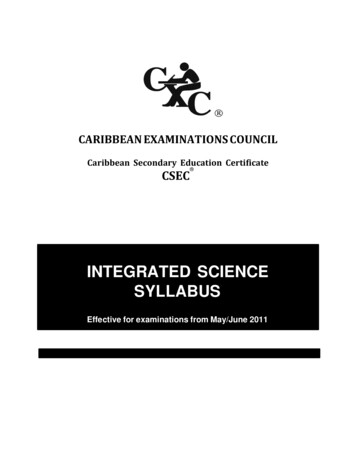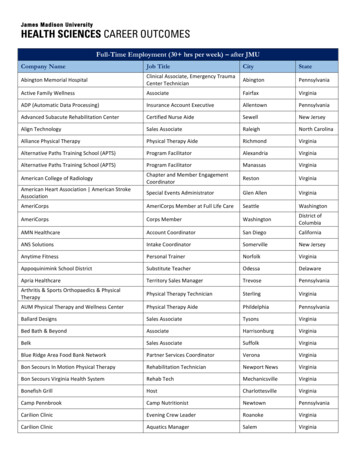
Transcription
Pennsylvania Integrated Standards for Science,Environment and Ecology (Grades 6-12)
ContentsAcknowledgments . iiIntroduction .1Pennsylvania’s Vision .1Development of the Standards .2What Is an Integrated Science, Environment and Ecology Education?.3Scientific, Environmental and Technological Literacy in Pennsylvania .4Structure of the Standards .4Science and Engineering Practices .6Anatomy of a PA Standard .7How to Use the Standards .9Resources for Integration .10Standards for Grades 6-8 .11Physical Science .11Life Science .12Earth and Space Science .14Engineering, Technology, and Applications of Science .15Standards for Grades 9-12 .16Physical Science .16Life Science .18Earth and Space Science .20Engineering, Technology, and Applications of Science .21References .22Appendix A. Glossary.24Appendix B. Example of a Standard.26Appendix C. Intersection of Pennsylvania’s Career Ready Skills, Dispositions and Habitsof Mind .27American Institutes for Researchi
AcknowledgmentsThe Pennsylvania Department of Education (PDE) wishes to first thank the State Board ofEducation for providing the opportunity to review, revise and provide recommendations on theScience and Technology and Environment and Ecology K-12 standards.Thanks to the nearly 1,000 individuals across Pennsylvania who attended a stakeholderfeedback session, answered a survey or participated in a focus group. You provided valuablecontent and direction to inform the review, revisions and recommendations for an innovative setof standards to guide science, technology, environment and ecology education in Pennsylvania.Thanks to the Berks County Intermediate Unit team, led by Dan Richards, for supporting thelogistics in gathering stakeholder input during the development of the Landscape Report and inorganizing the focus groups.Thanks to the 74 members of the content and steering committees for lending your valuableexpertise and time. Your research, critical feedback and tireless efforts to improve science,technology, environment and ecology education by reviewing, revising and generatingrecommendations with a focus on equity for every student and teacher in Pennsylvania set ahigh standard.Special thanks to the writing committee for volunteering countless hours in a difficult season,through a pandemic and transition to an uncertain school year, to craft a thoughtful set ofrecommendations to the State Board of Education. Your work will guide and inspire the nextgeneration of educators and learners.There are several committee members who took on leadership roles of the writing teams.Thanks are due to them for ensuring, in the final months of the committees’ work, that thestakeholder input, research, committee discussions and everything that went into the processcame to fruition in the form of proposed standards to present to the State Board of Education.Thank you:Darren Myzak, High School Science Teacher (Biology, Chemistry), Pine-Richland SchoolDistrictBrian Suter, K-12 Lead Science Teacher, Neshaminy School DistrictSteve Kerlin, Ph.D., Director of Environmental Education, Stroud Water Research CenterJaunine Fouché, D.Ed., K-12 Science Curriculum Supervisor, Director of STEAM Initiatives andAgricultural & Environmental Education, Milton Hershey SchoolFinally, thanks to the American Institutes for Research (AIR) team. The AIR team has embracedPDE’s vision for a stakeholder-driven, research-based process to guide the review, revision anddevelopment of recommendations for Pennsylvania’s Academic Standards for Science andTechnology (2002) and Academic Standards for Environment and Ecology (2002). This couldnot have been such a stakeholder-driven and innovative process without AIR’s partnership—American Institutes for Researchii
from authoring the Landscape Report; to facilitating stakeholder sessions, committee meetingsand focus groups; to incorporating and adapting to feedback throughout the process.Thank you to the whole AIR team, in particular:Dr. Bobbi Newman, Senior Researcher (Project Director)Beth Ratway, Senior Technical Assistance Consultant (Project Facilitator)Dr. Teresa Smith Neidorf, Principal Research Scientist (Project Advisor)Dr. Danielle Ferguson, Researcher and Senior STEM Content ExpertWill (Tad) Johnston, Senior Technical Assistance Consultant specializing in mathematics andscience educationDebbie Menard, Research Associate Intern and High School Biology TeacherAmerican Institutes for Researchiii
IntroductionThe Pennsylvania Integrated Standards for Science, Environment and Ecology (Grades 6-12)use a three-dimensional approach to guide the study of the physical sciences, life sciences andEarth and space sciences at the middle and high school levels. The standards highlight thecritical intersections of these disciplines with environmental science, ecology and agriculture, aswell as engineering, technology and applications of science. These three-dimensional standardsintegrate disciplinary core ideas, practices in science and engineering and crosscuttingconcepts into a coherent set of expectations for student learning that build progressively acrossthe grade bands for middle school (6-8) and high school (9-12).The new Pennsylvania standards build upon the National Research Council’s (NRC’s) AFramework for K-12 Science Education (The Framework). Like The Framework, thePennsylvania Integrated Standards for Science, Environment and Ecology (Grades 6-12) arebased on current research in student learning and take a three-dimensional approach thatintegrates disciplinary core ideas, practices in science and engineering and crosscuttingconcepts into a coherent set of expectations for student learning that builds progressivelyacross grades. The expectations laid out in the middle and high school science, environmentand ecology standards build upon those in the companion standards for elementary school, thePennsylvania Integrated Standards for Science, Environment, Ecology, Technology andEngineering (Grades K-5). In addition to this set of K-12 standards for science education,separate technology and engineering education standards for middle and high school were alsodeveloped: the Pennsylvania Technology and Engineering Standards (Grades 6-12).Pennsylvania’s VisionBusinesses and industries are growing in Pennsylvania, and they want skilled and welleducated workers who are prepared for the 21st century economy. Students need to beequipped with the knowledge and skills to enter the workforce and to be successful in a scienceand technology-driven global economy.To best prepare students for the 21st century economy, Pennsylvania aims to establish anequitable and innovative culture so every student can be included in science, engineering,technology, environment and ecology education. Pennsylvania’s Standards for IntegratedScience, Environment and Ecology were established on the following foundational beliefs: Every student is capable of science, engineering, technological and environmental literacy. Science, environment, ecology, technology and engineering can be explored through anintegrated and active learning process. Iteration and reflection are a critical component of the learning process. Success depends upon the partnerships between educators, students, families,postsecondary providers and institutions, legislators, businesses and industries.American Institutes for Research1
These draft standards were developed with this vision in mind, with contributions and voices ofstakeholders across the commonwealth.Development of the StandardsThe Pennsylvania State Board of Education directed PDE to begin the process of updatingPennsylvania’s Academic Standards for Science and Technology (2002) and AcademicStandards for Environment and Ecology (2002) to align them with current research and bestpractices. From February through March 2020, 14 stakeholder engagement sessions were heldacross the state and virtually. Of the more than 960 members of the public who provided inputat these sessions, most were elementary and secondary educators, school administrators,postsecondary educators, student teachers, business and industry representatives, communitynot-for-profit organization representatives, parents and students. Their feedback was capturedin a report that summarized the current research and best practices regarding science,environment, ecology, technology and engineering standards (see Ferguson et al., 2020).In April 2020, PDE solicited applications from interested members of the public to serve oncommittees to review and revise the standards. Applicants were selected through a multireviewer process on the basis of their depth and breadth of expertise in curriculum andstandards development, understanding of the existing standards and current research, equityand access in education and meeting needs of diverse learners and overall educationexperience. Each selected committee member was approved by the State Board of Education inMay 2020.In June and July, the committees met to review the stakeholder input as well as research-basedframeworks and guidelines—such as the National Research Council’s (NRC’s) A Framework forK–12 Science Education: Practices, Crosscutting Concepts, and Core Ideas (2012), NorthAmerican Association for Environmental Education’s (NAAEE) K–12 Environmental Education:Guidelines for Excellence (2019), Ecological Society of America’s (ESA) Four-DimensionalEcology Education (4DEE) framework (2018), International Technology and EngineeringEducators Association’s (ITEEA) Standards for Technological and Engineering Literacy (STEL)(2020), International Society for Technology in Education’s (ISTE) Standards for Students(2019), National Council for Agricultural Education (NCAE) Agriculture, Food and NaturalResources (AFNR) Career Cluster Content Standards (2015) and other national andinternational frameworks. Committee members also conducted close reads to share relevantinformation from Pennsylvania-specific documents, such as Pennsylvania’s AcademicStandards for Science and Technology (2002) and Academic Standards for Environment andEcology (2002) to inform the development of the revised standards. Committee memberscollaborated to identify key content within those research-informed frameworks and other keynational and international standards in science, environment, ecology, technology, engineeringAmerican Institutes for Research2
and agriculture. 1 They sought to identify cross-content connections while adding sustainability,PA Career Ready Skills and other PA-specific contexts.Over nine full-day convenings, the committee members discussed the essential elements ofacademic standards. Attention to equity and access surfaced as foundational in thedevelopment of the standards. Equity in the context of the standards can be defined as afoundation of knowledge and skills critical for and accessible to all students, as well as “acharacteristic of the instructional environment that increases the capacity for everyone toparticipate in meaningful learning” (Windschitl, Thompson, & Braaten, 2018, p. 12). This beginswith standards that are crafted to allow for the individual and personalized experiences,knowledge and skills that students bring with them to the classroom.Following recommendations from current research to ensure equitable opportunities exist for allstudents and research indicating how students learn best, committee members drafted theserevised standards based on the committees’ commitment to equity and inclusivity to open doorsto STEM fields for all students. Therefore, the practices embedded in the standards provide anequitable on-ramp for all students as they transition their developing and experience-basednotions of the scientific world to conceptions that are scientifically based.The PA Integrated Standards for Science, Environment and Ecology (Grades 6-12) weredeveloped in parallel with the PA Integrated Standards for Science, Environment, Ecology,Technology and Engineering (Grades K-5). In this document, as well as in the PA IntegratedStandards for Science, Environment, Ecology, Technology and Engineering (Grades K-5), theorganization and presentation of the standards are similar, thus creating a cohesive K-12integrated approach to science, environment and ecology education in Pennsylvania.What Is an Integrated Science, Environment and Ecology Education?The interconnectedness of the world and its impact on science, environment, ecology,technology and engineering have never been more prominent. Engineering, technology andscience are fields critical to innovation, and a commitment through the standards to expose allstudents to scientific and engineering practices can spark interest in the study of STEM or futureSTEM careers (National Science Foundation [NSF], 2010). Presenting the standards forscience, environment, ecology and agricultural together in a single document provides contentsupport in these areas to middle and high school teachers and makes the standards moreaccessible when developing innovative STEM curricula that integrate related content.Understanding the components of ecological systems and their interrelationships with socialsystems and technologies is vital to the development of STEM-literate citizens. Thesecomponents incorporate the disciplines of resource management, agricultural diversity,government and the impact of human actions on natural systems. This interaction leads to thestudy of watersheds, threatened and endangered species and pest management, and to thedevelopment of associated laws and regulations. Integrating science, environment and ecologyContent and steering committee members reviewed over 30 research-based frameworks, guidelines andPennsylvania-specific documents, such as the Pennsylvania Environmental Literacy Plan and the 22 Pa. CodeChapter 4 Academic Standards and Assessment.1American Institutes for Research3
in the science standards emphasizes the deep interconnectedness among these areas. Thisencourages integrated teaching across these disciplines in a way that not only presents thesecritical concepts in their full context, but also promotes equity by ensuring that environment,ecology, engineering, technology and applications of science are well covered in sciencecourses across grades K-12.Scientific, Environmental and Technological Literacy in PennsylvaniaPennsylvania’s workforce is continually influenced by the needs of an economy driven byscience and technology. To best prepare each of Pennsylvania's 1.7 million students for thefuture workforce, educators need innovative standards that develop a scientific, environmentallyand technologically literate citizenry. “Literacy” requires more than possessing knowledge;literacy requires being able to apply knowledge. A scientifically and environmentally literateperson can apply the knowledge, concepts, skills, processes and practices of those fields toreal-life situations. This includes engaging in scientific inquiry and applying science conceptsand processes to make decisions for oneself, participate in civic and cultural affairs andcontribute to society and the economy through one’s work (Ashbrook, 2020). Environmentalliteracy also requires knowledge and understanding of environmental concepts, problems andissues in order to make informed decisions concerning the local and global environment that willimprove the well-being of individuals and societies through participation in civic life (NAAEE,2019). Technologically literate individuals, in addition to being able to use and understandtechnology, can apply science knowledge and skills to develop solutions to real-world problemsand appreciate the distinctions and relationships between engineering, technology andapplications of science.Structure of the StandardsThe Pennsylvania Integrated Standards forScience, Environment and Ecology (6-12) buildupon the National Research Council’s (NRC’s) AFramework for K-12 Science Education (TheFramework) and the Next Generation ScienceStandards (NGSS). The main dimensions of TheFramework and the Pennsylvania IntegratedStandards for Science, Environment and Ecology(6-12) are similar; however, there are aspectsthat are specific to the Integrated PennsylvaniaStandards for Science, Environment and Ecology(Figure 1).Figure 1. Structure of the PennsylvaniaStandards for Integrated Science,Environment and EcologyLike The Framework, the PennsylvaniaIntegrated Standards for Science, Environmentand Ecology (6-12) are built around three dimensions that are integrated into the set of specificAmerican Institutes for Research4
standards at each grade level—Disciplinary Core Ideas (DCIs), Science and EngineeringPractices and Crosscutting Concepts—described below.DCIs reflect essential ideas in science that all students should understand by the end of grade12. DCIs are included for four major disciplines or domains in the natural sciences—physicalsciences, life sciences and Earth and space sciences—as well as for engineering, technologyand applications of science. Within each of these four domains, there is a set of DisciplinaryCore Ideas (Core Ideas) presented by grade band (Table 1).Table 1. Domains and Core Ideas by Grade BandsDomainsPhysical SciencesLife SciencesCore Ideas for Grades 6-8Core Ideas for Grades 9-12 Structure and Properties ofMatter Structure and Properties ofMatter Chemical Reactions Chemical Reactions Forces and Interactions Forces and Interactions Energy Energy Waves and ElectromagneticRadiation Waves and ElectromagneticRadiation Structure and Function, andInformation Processing Structure and Function Matter and Energy inOrganisms and Ecosystems Matter and Energy inOrganisms and Ecosystems Interdependent Relationships in Interdependent Relationships inEcosystemsEcosystems Inheritance and Variation of Growth, Development andReproduction of Organisms Natural Selection andAdaptationsEarth and SpaceSciencesTraits Natural Selection and Evolution Space Systems Space Systems History of Earth History of Earth Earth’s Systems Earth’s Systems Weather and Climate Weather and Climate Human Impacts Human SustainabilityAmerican Institutes for Research5
DomainsEngineering,Technology andApplications ofScience 2Core Ideas for Grades 6-8Core Ideas for Grades 9-12 Define Problems Define Problems Develop Solutions Develop Solutions Improve Designs Improve DesignsScience and Engineering PracticesThe Science and Engineering Practices are behaviors that are critical in investigating, modelingand explaining the world, as well as in developing solutions to societal problems. The eightScience and Engineering practices are:1. Asking questions (for science) and defining problems (for engineering);2. Developing and using models;3. Planning and carrying out investigations;4. Analyzing and interpreting data;5. Using mathematics and computational thinking;6. Constructing explanations (for science) and designing solutions (for engineering);7. Engaging in argument from evidence; and8. Obtaining, evaluating and communicating information.The Crosscutting Concepts bridge disciplinary boundaries and unify the study of science andengineering. In addition to the seven Crosscutting Concepts from The Framework, sustainabilityis added as an eighth Crosscutting Concept in the PA Standards for Integrated Science,Environment and Ecology (6-12). Sustainability refers to meeting the needs of the presentwithout compromising the ability of future generations to meet their needs (Stone & Barlow,2005, p. xiii). The eight Crosscutting Concepts that appear in the PA Standards for IntegratedScience, Environment and Ecology (6-12) are:1. Patterns;2. Cause and effect;3. Scale, proportion and quantity;4. Systems and system models;5. Energy and matter;6. Structure and function;2Thediscipline of Engineering, Technology and Applications includes two core ideas: Engineering Design and LinksAmong Engineering, Technology, Science, and Society. Specific DCIs are included for the area of EngineeringDesign but not for Links Among Engineering, Technology, Science, and Society. Rather, connections to the lattercore idea are identified for DCIs within the science disciplines, where appropriate.American Institutes for Research6
7. Stability and change; and8. Sustainability.Each component of a standard is explained in more detail below. For terms related to thestandards, see Appendix A.Anatomy of a PA StandardAs illustrated below, the standards for each Core Idea are organized in three main sections:(1) Performance Expectation(s), (2) foundation boxes and (3) connections. Appendix B providesan example of a completed standard.Standard StructureGrade Level: Domain from Earth and space sciences; environment and ecology; life sciences;physical sciences; or technology and engineeringCore Idea:Performance Expectation (PE): Students who demonstrate understanding can:DimensionsScience and EngineeringPracticesDisciplinary Core IdeasCrosscutting ConceptsPA Connections: Integration of EE, T&E, PA Career Ready Skills and PA ContextConnections to Other StandardsELA: PA CoreStandards: ELAMath: PA CoreStandards: MathEducationalTechnology(ISTE Standards forStudents)Agriculture, Food,and NaturalResources (AFNR)Career ClusterContent Standards;NAAEEGuidelines forExcellenceAmerican Institutes for Research7
Performance Expectations: Below the Core Idea is a box containing a set of performanceexpectations. Each Core Idea includes one or more performance expectations written as tasksthat students at the specified grade level should be able to complete to demonstrate mastery ofthe content.Foundation Boxes: Below the Performance Expectations box are three foundation boxes,which list (from left to right) the specific Science and Engineering Practices, Disciplinary CoreIdeas and Crosscutting Concepts used to develop the set of Performance Expectations.PA Connections: Below the Foundation boxes are links to possible PA connections that allowfor integrated science instruction that leverages local and regional context as well asconnections to Pennsylvania’s Academic Standards for Science and Technology (2002),Academic Standards for Environment and Ecology (2002) and PA Career Ready Skills. PAconnections also allow for integrated science instruction that leverages local and regionalcontext.Connections to Other Standards: In addition to the PA connections above, connection boxesare provided for the PA Core Standards for English Language Arts (ELA) and PA CoreStandards for Mathematics; ISTE Standards for Students; the Agriculture, Food and NaturalResources (AFNR) Career Cluster Content Standards; and the K–12 Environmental Education:Guidelines for Excellence (2019) (NAAEE). These sections are described in further detail below.How to Use the StandardsPerformance ExpectationsPerformance expectations (PEs) are statements of what students should know and be able todo. Each PE is written to include a practice, core idea and crosscutting concept. Each standardincludes both the PE(s) and the contents of the three foundation boxes. In Pennsylvania, allstudents should be held accountable for demonstrating their achievement of all PEs, which arewritten to allow for multiple means of assessment. Students should demonstrate proficiency inall of these standards by the end of grade 12. Following the PEs are clarification statements thatprovide suggested examples or clarification to the PEs. PEs may also contain assessmentboundary statements, which set limits or parameters for large-scale assessment. Further, thePEs are not meant to limit the curriculum, nor are they a set of instructional or assessmenttasks.Foundation BoxesPEs are the result of the integration of the three dimensions that appear in the foundationboxes. As curriculum and instruction are developed, these dimensions must be taught together.The three dimensions of Science and Engineering Practices, Disciplinary Core Ideas andCrosscutting Concepts should be assessed together. While new in the proposed PA Standardsfor Integrated Science, Environment and Ecology (6-12), the (1) inclusion of and (2) assessmentwith practices can already be seen across the PA Core Standards for English Language Artsand the PA Core Standards for Mathematics. For example, in all three content areas, studentsAmerican Institutes for Research8
are expected to engage in argumentation from evidence; construct explanations; obtain,synthesize, evaluate and communicate information; and build a knowledge base throughcontent rich texts across the three subject areas.Connection BoxesThe connection boxes are included to support curriculum and instruction and, where possible,connect to Pennsylvania’s other academic standards and PA Career Ready Skills.PA Connections: PA connections are provided to leverage opportunities in curriculum andinstructional design for students to engage in local, regional contexts and phenomena inPennsylvania. Some connections to the Pennsylvania Academic Standards for Environment andEcology (2002) 3 appear as associated phenomena in the PA Connections boxes. Other PAConnection statements not derived from the 2002 standards are also included where there areopportunities to relate standards to regional and local phenomena. Each standard also includesPA Connections to Career Ready Skills. Educators can use this resource in conjunction with thePA Career Ready Skills Continuum to identify ways to integrate teaching science, environmentand ecology and technology and engineering with related employability skills at any grade level.For the development of the PA connections related to PA Career Ready Skills, see Appendix C.Connections to Other Standards: Connection boxes are also included to create a morecoherent version of the standards by illustrating how each PE connects to state or nationaldocuments, including the PA Core Standards for English Language Arts and the PA CoreStandards for Mathematics, ISTE Standards for Students, NAAEE Guidelines for Excellence,and NCAE AFNR Career Cluster Content Standards. These can be especially useful incurriculum and instructional design for identifying natural fits for technology, agriculture andenvironmental education. The cross-walked standards can be explicitly taught in the context ofattaining the related PE. The cross-walked standards are not a complete list of all potentialcrosswalks. Depending on how standards are used in local curriculum development, additionalcrosswalks may be identified.3 Connectionsto the Pennsylvania Academic Standards for Environment and Ecology (2002) are only included if theyare not explicitly covered by the new standards developed based on The Framework.American Institutes for Research9
Resources for IntegrationThe Pennsylvania Integrated Standards for Science, Environment and Ecology (6-12) aredesigned to be used in developing integrated classroom learning experiences and formative andsummative assessments. Pennsylvania is fortunate to be rich with environmental learning andnature centers, STEM ecosystems and public libraries and community-based organizations thatprovide out-of-school time for STEM and environmental education. Environment and ecologyand STEM providers across the state are valuable resources for providing age-appropriatelessons, opportunities, expertise and outdoor real-life experiences for Pennsylvania students sothat classroom educators can more easily integrate the standards.American Institutes for Research10
Standards for Grades 6-8 45
technology and engineering have never been more prominent. Engineering, technology and science are fields critical to innovation, and a commitment through the standards to expose all students to scientific and engineering practices can spark interest in the study of STEM or future STEM careers (National Science Foundation [NSF], 2010).










